Pretty little Annie Vernay (1921-1941) catapulted into stardom at an early age, but the career of the Swiss-French actress was cut short. She died only 19 years old.

French postcard by Editions P.I., Paris, no. 25. Photo: Teddy Piaz.
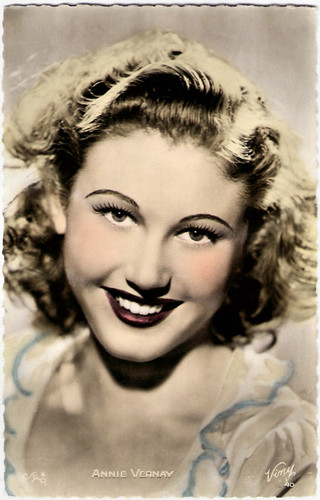
French postcard by Viny, no. 40. Photo: Star. With an autograph by Vernay at the flipside, dated 11 May 1940.

French postcard by Erpé, no. 568. Photo: Star.
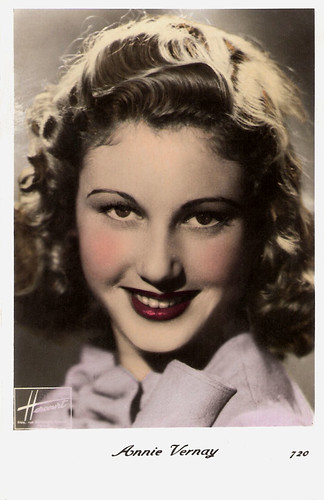
French postcard, no. 720. Photo: Harcourt.
Annie Vernay was born Annie-Martine-Jacqueline Vermeersch in Genève-Plainpalais, Switzerland, in 1921. Her father, Gaston Vermeersch, was a rich industrialist.
As her mother Germaine Vermeersch couldn't realise an artistic career because of her marriage de raison, she pushed her daughter into an artistic career after her husband died and she inherited his fortune. She applied her daughter for Jugement d’Hélène, a beauty contest in Paris, when the girl was 16 years old.
During holidays at Juan les Pins a friend of film director Victor Tourjansky spotted her and recommended her to him. Tourjansky engaged her for the role of Lisl in his film Le mensonge de Nina Petrovna/The Lie of Nina Petrovna (Victor Tourjansky, 1937), which starred Italian star Isa Miranda and Fernand Gravey. The film had been shot earlier in Germany as Die wunderbare Lüge der Nina Petrowna (Hanns Schwarz, 1929) with Brigitte Helm.
Vernay did so well that she was cast as the leading actress in the Italo-French multilingual La principessa Tarakanova/Betrayal (1938), shot at Cinecittà in Rome and directed by Russian director Fyodor Otsep and the Italian Mario Soldati.
Vernay played a princess who claims the Russian throne. Empress Catherine II (Suzy Prim) sends her lover and best soldier Orloff (Pierre-Richard Willm) to capture the impostor, but he falls for her beauty and innocence. The film had lavish sets of Venice and St. Petersburg and was one of the first Italian films shot in deep focus. It was a box office hit in 1938.

French postcard by A.N., Paris, no. 1139. Photo: Harcourt.
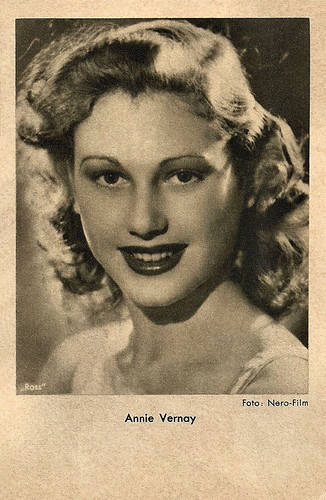
German postcard by Ross. Photo: Nero-Film.

Italian postcard by Rizzoli, Milano, 1938, XVI. Photo: Pesce.
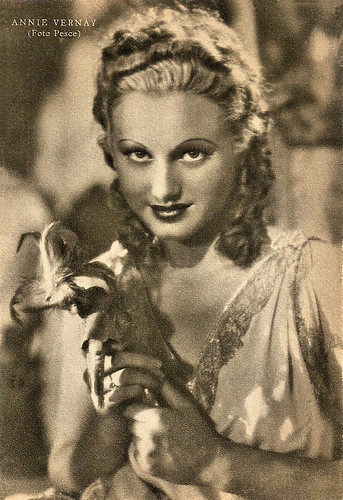
Italian postcard by Rizzoli, Milano. Photo: Pesce.
Annie Vernay’s mother, who had become her agent and coach as well, knew she had gold in her hands. Annie herself, more sober, continued her studies in between shootings. The result was that the famous producer Seymour Nebenzahl of Nero Film engaged Vernay for several films.
The first was Max Ophüls’ adaptation of Johann Wolfgang Goethe’s Die Leiden des jungen Werthers: Le roman de Werther/Sorrow of Werther (Max Ophüls, 1938). It featured Pierre-Richard Willm as Werther and Vernay as Charlotte/Lotte, the girl for whom Werther commits suicide. The film confirmed Vernay’s status as a new French film star, competing with young stars like Danielle Darrieux.
When World War II broke out in the summer of 1939, French film production hesitated but still continued, enabling Vernay to play in more films: the World War One drama Les otages/The Mayor's Dilemma (Raymond Bernard, 1939) with Pierre Larquey, Dédé la musique/Dédé of Montmartre (André Berthomieu, 1939) with Albert Préjean, Chantons quand même/Let us sing all the same (Pierre Caro, 1940), and the crime film Le collier de chanvre/Hangman's Noose (Léon Mathot, 1940) with Jacqueline Delubac.
Because of the pending German invasion of France, Annie Vernay intended to return to Switzerland, but at that moment she received an offer from Hollywood to play the role of a foreign woman in a movie called Rick's Café. Annie’s mother convinced her to accept the offer, so they travelled to the US via Argentine, on one of the last freighters to leave France.
Aboard the ship, though, Annie fell ill of typhoid and died in a hospital after her arrival in Buenos Aires, in August 1941. Annie Vernay was only 19 years old. Germaine Vermeersch never got over the loss of her daughter.
Other candidates for the same role in Rick's Café had been Hedy Lamarr and Michèle Morgan but eventually it would give Ingrid Bergman everlasting fame. The film in which Annie Vernay was supposed to play the female lead was later filmed as Casablanca (Michael Curtiz, 1942).
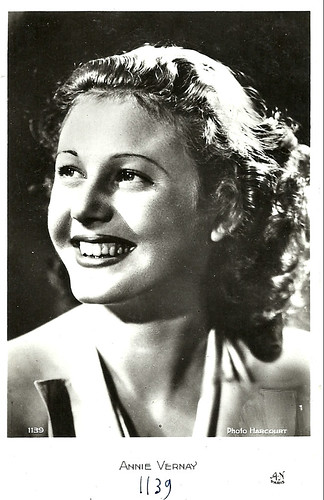
French postcard by A.N., Paris, no. 1139 Photo: Harcourt.
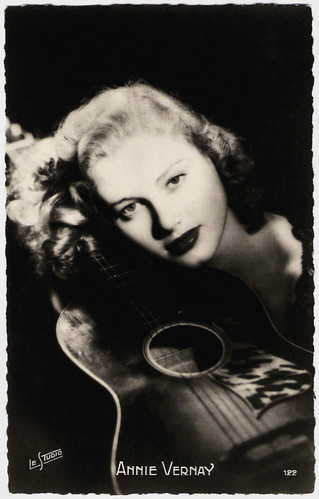
French postcard by O.P., Paris, no. 122. Photo: Le Studio.
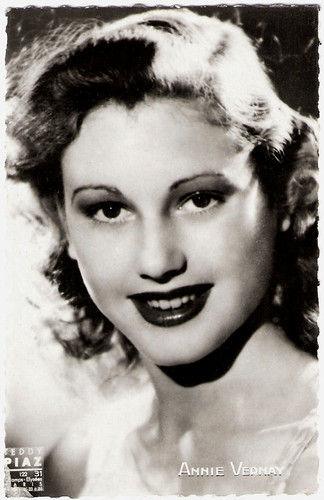
French postcard by P.I., Paris. Photo: Teddy Piaz.
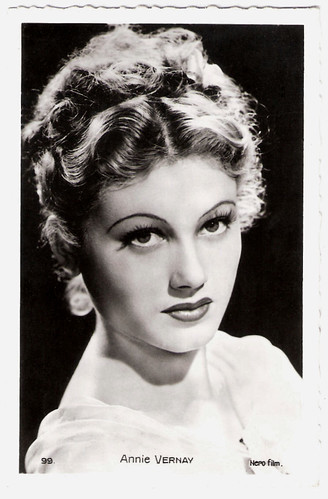
French postcard by Collection Chantal, Paris. Photo: Nero Film.
Sources: Thomas Staedeli (Cyranos), Cine Vedette (French), Caroline Hanotte & Philippe Pelletier (CinéArtistes), and IMDb.

French postcard by Editions P.I., Paris, no. 25. Photo: Teddy Piaz.

French postcard by Viny, no. 40. Photo: Star. With an autograph by Vernay at the flipside, dated 11 May 1940.

French postcard by Erpé, no. 568. Photo: Star.

French postcard, no. 720. Photo: Harcourt.
Pushing Mother
Annie Vernay was born Annie-Martine-Jacqueline Vermeersch in Genève-Plainpalais, Switzerland, in 1921. Her father, Gaston Vermeersch, was a rich industrialist.
As her mother Germaine Vermeersch couldn't realise an artistic career because of her marriage de raison, she pushed her daughter into an artistic career after her husband died and she inherited his fortune. She applied her daughter for Jugement d’Hélène, a beauty contest in Paris, when the girl was 16 years old.
During holidays at Juan les Pins a friend of film director Victor Tourjansky spotted her and recommended her to him. Tourjansky engaged her for the role of Lisl in his film Le mensonge de Nina Petrovna/The Lie of Nina Petrovna (Victor Tourjansky, 1937), which starred Italian star Isa Miranda and Fernand Gravey. The film had been shot earlier in Germany as Die wunderbare Lüge der Nina Petrowna (Hanns Schwarz, 1929) with Brigitte Helm.
Vernay did so well that she was cast as the leading actress in the Italo-French multilingual La principessa Tarakanova/Betrayal (1938), shot at Cinecittà in Rome and directed by Russian director Fyodor Otsep and the Italian Mario Soldati.
Vernay played a princess who claims the Russian throne. Empress Catherine II (Suzy Prim) sends her lover and best soldier Orloff (Pierre-Richard Willm) to capture the impostor, but he falls for her beauty and innocence. The film had lavish sets of Venice and St. Petersburg and was one of the first Italian films shot in deep focus. It was a box office hit in 1938.

French postcard by A.N., Paris, no. 1139. Photo: Harcourt.

German postcard by Ross. Photo: Nero-Film.

Italian postcard by Rizzoli, Milano, 1938, XVI. Photo: Pesce.

Italian postcard by Rizzoli, Milano. Photo: Pesce.
Rick's Café
Annie Vernay’s mother, who had become her agent and coach as well, knew she had gold in her hands. Annie herself, more sober, continued her studies in between shootings. The result was that the famous producer Seymour Nebenzahl of Nero Film engaged Vernay for several films.
The first was Max Ophüls’ adaptation of Johann Wolfgang Goethe’s Die Leiden des jungen Werthers: Le roman de Werther/Sorrow of Werther (Max Ophüls, 1938). It featured Pierre-Richard Willm as Werther and Vernay as Charlotte/Lotte, the girl for whom Werther commits suicide. The film confirmed Vernay’s status as a new French film star, competing with young stars like Danielle Darrieux.
When World War II broke out in the summer of 1939, French film production hesitated but still continued, enabling Vernay to play in more films: the World War One drama Les otages/The Mayor's Dilemma (Raymond Bernard, 1939) with Pierre Larquey, Dédé la musique/Dédé of Montmartre (André Berthomieu, 1939) with Albert Préjean, Chantons quand même/Let us sing all the same (Pierre Caro, 1940), and the crime film Le collier de chanvre/Hangman's Noose (Léon Mathot, 1940) with Jacqueline Delubac.
Because of the pending German invasion of France, Annie Vernay intended to return to Switzerland, but at that moment she received an offer from Hollywood to play the role of a foreign woman in a movie called Rick's Café. Annie’s mother convinced her to accept the offer, so they travelled to the US via Argentine, on one of the last freighters to leave France.
Aboard the ship, though, Annie fell ill of typhoid and died in a hospital after her arrival in Buenos Aires, in August 1941. Annie Vernay was only 19 years old. Germaine Vermeersch never got over the loss of her daughter.
Other candidates for the same role in Rick's Café had been Hedy Lamarr and Michèle Morgan but eventually it would give Ingrid Bergman everlasting fame. The film in which Annie Vernay was supposed to play the female lead was later filmed as Casablanca (Michael Curtiz, 1942).

French postcard by A.N., Paris, no. 1139 Photo: Harcourt.

French postcard by O.P., Paris, no. 122. Photo: Le Studio.

French postcard by P.I., Paris. Photo: Teddy Piaz.

French postcard by Collection Chantal, Paris. Photo: Nero Film.
Sources: Thomas Staedeli (Cyranos), Cine Vedette (French), Caroline Hanotte & Philippe Pelletier (CinéArtistes), and IMDb.
No comments:
Post a Comment